Because the night before, my brother took us to the night club in Siem Reap and played karaoke too high, I returned to the hotel in the middle of the night. So on the last day in Angkor, we didn't go to see the roluos complex as planned I went to Angkor and Angkor again. In fact, we have been to Angkor twice. When we turn around, we have been to the most famous bayong temple. When we turn around, we finally watch the sunset at the Douxiang platform. However, because of its large scale, we have not visited many scenic spots, such as Bafang temple, air palace and epileptic king platform. Angkor has been to Angkor twice, one sunrise and one sunset. However, due to the short time, I didn't appreciate it carefully, especially the exquisite murals on the inner corridor. These constitute our third day's journey.
The official name of Angkor should be Angkor Tongwang City, which is the last capital of Khmer empire. It was built at the end of the 9th century, Jayavarman 7. From about 1181 to 1215, he drove out the invading zhanpo people and rebuilt them, which was called "the fourth Angkor".
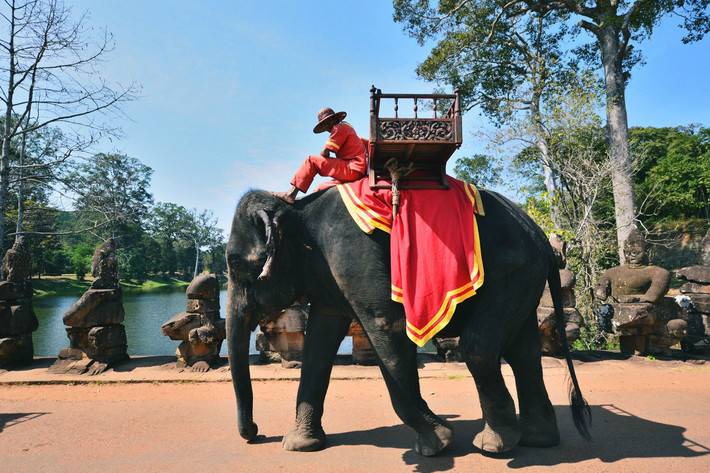
The elephant passing through the South Gate Bridge.
Tongwang City
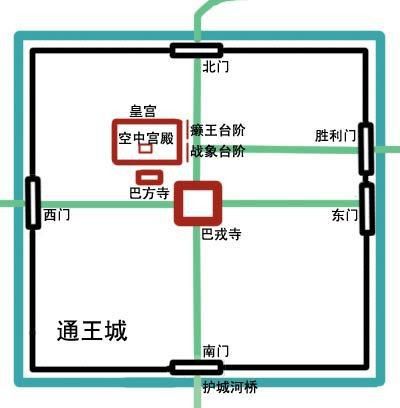
Tongwang City
Angkor Tongwang city is square. There are five gates in the city, four leading to the bayong temple in the center of the city, and one "victory gate" leading to the imperial palace. On the gate are four Buddha statues facing the four directions. Among them, the south gate and the north gate are used for people's daily entry and exit, while the east gate is used for cremation after people's death, the west gate is used by prisoners, and the "victory gate" leading to the Imperial Palace, as the name suggests, is used by the army to return triumphantly. Therefore, it is suggested that people should go to the south gate, the north gate and the victory gate to get in and out of Angkor Tong.
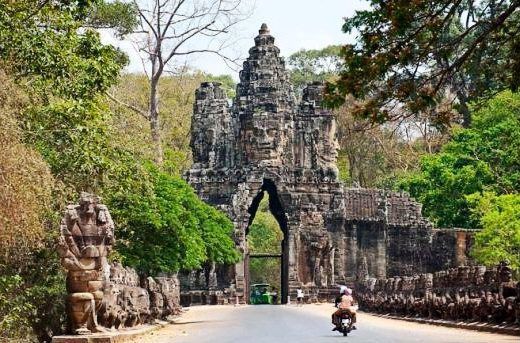
Each of the five Gates has a bridge across the moat. There are 27 stone statues on each side of the bridge, which are Shura and Asura respectively. The 54 stone statues symbolize the 54 city states in the heyday of Angkor Dynasty. The stone statue is 2.5 meters high, kneeling and holding the snake king vasuki in his arms. This is the legendary Indian myth, the sea of stirred milk. South Gate (picture from Internet)
Tongwang City
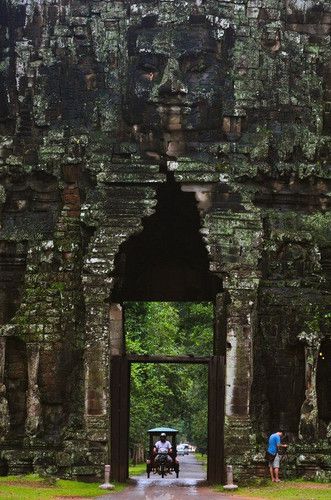
Shengli gate (picture from Internet)
Tongwang City
The Bafang temple is udayadityavarman 2. The national temple dedicated to Shiva was built in 1060. It is located 200 meters northwest of the bayong temple, close to the south wall of the royal palace. Bafang temple is known as the largest and most complex three-dimensional building in the world.
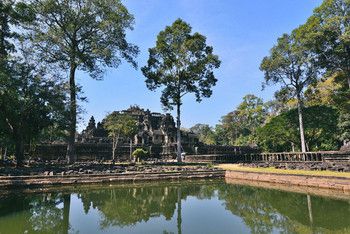
Papang monastery
Papang monastery
Bafang temple is a mount Meru temple, in the shape of a pyramid. The whole temple has a total of five levels of platform foundation. On the first, the third and the fifth level of platform foundation, there are closed corridors. There are towers in the center and four corners of the four sides of the corridor.
Papang monastery
Climb up the steep stairs.
Papang monastery
On the foundation of the fifth floor, there is a stone pagoda about 50 meters high wrapped in huge copper sheet, which is higher than the gold Pagoda in the center of Bayang temple in the southeast. The highest point of the copper pagoda symbolizes the center of all things in the universe. Zhou Daguan's Zhenla Fengtu Ji: there is a copper tower about one mile north of the gold tower. It's higher than the gold pagoda. It's gloomy to look at. There are more than ten stone houses under it.
Papang monastery
Papang monastery
Papang monastery
Papang monastery
Papang monastery
France began to help Cambodia repair the Bafang temple in 1960. At that time, archaeologists numbered thousands of collapsed stones and placed them in the open space in front of the temple, hoping to piece them together. After the Khmer Rouge regime came to power in 1975, it drove away French experts, slaughtered Cambodians who helped the French repair historic sites, and destroyed all archives. Although the French started the restoration work again in 1995, due to the lack of technical data, these stones can no longer be placed in the original place, and all the restoration work has to use new stones. It turns out that these thousands of stones can only lie on the square in front of the temple forever, as a witness of the glory of the past and the turbulence of modern times.
The main gate of Bafang Temple faces east. After entering the east gate, what appears in front of you is a long approach road, which is about 170 meters long and erected by about 1.5-meter-high round stone pillars. There are two pools on both sides of the guide road. This layout is somewhat similar to Angkor.
Papang monastery
Papang monastery
The palace in the sky was originally the king of Zhenla, R ā jendravarman II ) During his reign (941-968), the temple of Shiva was built at the same time as the king's palace. Later, it was transformed into a Hindu temple of Xumishan style by suliyebamo I.
The palace in the sky is made up of three layers of rectangular xumitai, which are overlapped into a pyramid, symbolizing xumitai mountain. The four corners of xumitai on each layer are decorated with lions or elephants. Xumitai is made of red clay bricks. In the middle of the four sides of xumitai mountain, there are steep steps connecting the upper layer. There is an incomplete Gallery around xumitai on the top floor. In the center of xumitai on the top floor of the palace in the sky, there is no gold pagoda. These structures show that it is the predecessor of Angkor Wat.
Air Palace
The golden pagoda of the palace in the sky is the king's bedroom. The king will go to the golden pagoda to sleep every night. According to folklore, nine headed snake spirits worshipped by Khmer people live in the golden pagoda. They turn into women at night and have sex with the king. Although the queen does not dare to enter. Two drums just came out to sleep with the queen. If the snake spirit is not seen for a day, the king's death is near. If the king does not go for a day, disaster will surely come.
Air Palace
Although the air palace is called a palace, it is not a palace. The palace is about 200 meters to the northeast of it. Because it is a wooden structure, it is no longer there. Only the entrance of the palace is still there.
Air Palace
The stone statue on the side of the palace, I don't know where he would be in that year to observe the gratitude and resentment of the harem every day?
Air Palace
Air Palace
Air Palace
It is located in the north of the Douxiang platform and connected with it for 300 meters M, including the main platform and two subsidiary platforms. The platform is 25 meters in length and 25 meters in width, and tends to be octagonal due to the four corners being concave inward. It was created in the 13th century by Jayavarman VII) It was built.
Zanwangtai is an exquisite two-story platform. There is a narrow corridor at the bottom. The labyrinth corridor at the bottom of the platform is in the shape of a palindrome. Because the corridor is very secret, it can avoid the destruction of the war and retain a fairly complete statue.
The steps of the toad King
These reliefs have six to seven layers, which are composed of rows of gods. The bottom layer is supported by Naja with five, seven or nine heads.
The steps of the toad King
The theme of stone carving is mostly about gods and the underworld, that is, the story of hell's judgment and torture.
The steps of the toad King
The images of the stone carvings on the wall are exquisite, and the contents of the carvings are layer by layer. The carvings of gods in different shapes are very vivid, with a bit of gloom.
The steps of the toad King
There is a statue in cassock in the middle of the top of the crazy king platform. It is said that once upon a time, there was a king who was immoral and unpopular. Even the snake spirit who protected the king finally sprayed snake venom on him, so he suffered from leper, which is also called leper King)。 It is also said that the king of leprosy is the incarnation of jayabama VII. It is said that he himself suffered from leprosy, so he built 102 hospitals in large quantities. It is also said that jayabama VII was built for jayabama IV suffering from leprosy. In order to make the king better, this platform was built in front of the National Palace. There are thousands of Buddha statues around the platform to pray for the king.
When we were on the West Gate Bridge in little Angkor, three young monks were walking in front of us. The dress of the middle one is more gorgeous. I wonder if it represents a higher status? Or more knowledgeable?
Angkor Wat
As I mentioned last time, because the relief of Angkor gallery is arranged counter clockwise, the correct order to observe the murals should also be counter clockwise. When you enter the first level corridor, you should turn right and watch them in turn: decisive battle in the field of Gulu, army of suliyebamo II, trial of Yama, mixing milk sea, Vishnu conquering the demons "The dark sky and the demon king Banna", "the battle between gods and demons".
Angkor Wat
The army of suryabamo II
Angkor Wat
War elephant
Angkor Wat
War horse
Angkor Wat
warrior
Angkor Wat
The sea of stirred milk is a famous Indian myth. It is said that there is an elixir hidden under the sea of milk. At first, the God (Shura) and the devil (Asura) fought for each other, but they all failed. Later, they protected the god Vishnu ( Vishnu) led the gods and demons to make a covenant and work together to get the medicine. Their method is to coil the body of the snake vasuki around the central mountain, 92 A Shura and eighty-eight A Shura turns the snake's body together to make the milk sea roll and throw out the elixir of immortality. But something went wrong in the middle of the way, the mountain was about to sink, and the snake couldn't stand it and vomited the venom. Creation of Brahma in times of crisis ( Brahma) The God of destruction Shiva ( Shiva) Drink up the venom, and Vishnu becomes a giant turtle to hold up the holy mountain. With the joint efforts of the three gods, the gods and Demons not only succeeded in obtaining the elixir of immortality, but also threw out all the treasures in the milk sea, including several goddesses such as apsaras.
The multi headed monster in the picture is Ravana, who was later killed by Prince Rama. In Asura's arms is vasuki, the seven headed snake king.
Angkor Wat
A total of 92 shuras and 88 Asuras participated in the mixing, together with the demon king lopona, the patron god Vishnu and the God Indra. In the middle is Vishnu, the great God, who commands both sides; Above is Indra, the God of heaven, who is helping to stabilize the mountain; Below is the tortoise king holding Mandala mountain.
Angkor Wat
The battle of gods and Demons
Angkor Wat
Apsaras with lotus. It is said that in the outer cloister there is the only lady in Angkor who shows her teeth. Unfortunately, we can't find her.
Angkor Wat
After 5 p.m., leave the outer corridor and continue to view the middle and inner corridors and buildings.
Angkor Wat
Middle corridor
Angkor Wat
Buddha with broken head
Angkor Wat
The inner corridor can be seen from the window of the middle corridor.
Angkor Wat
On the outside of the middle corridor, the setting sun just sprinkles on the window bars.
Angkor Wat
The outside of the outer cloister.
Angkor Wat
There are two lovers watching the sunset.
Angkor Wat
The inner corridor and the top lotus tower.
Angkor Wat
It's a pity that it's past 5:30 when I came to the lotus tower, and I still couldn't climb up to see the panoramic view of Angkor Wat from a high place.
Angkor Wat
So we went back to the west of the outer cloister, where we waited for the sunset with the people.
Angkor Wat
Sunset Angkor
Angkor Wat
And people sitting on balloons watching the sunset.
Angkor Wat
We sat on the cloister for a long time, unwilling to leave until the sun set completely.
Angkor Wat
Perhaps they are intoxicated with the dreamlike scenes interwoven by historical relics and religious buildings;
Angkor Wat
Perhaps after seeing too much of the beauty of ruins, we can't distinguish the past from the future.
Angkor Wat
I believe: we will definitely come back to Angkor in the future.
Angkor Wat
Angkor Wat
At that time, although we were no longer youth partners, we would take our parents and children with us to tell them some stories beyond life.
Angkor Wat
Goodbye, Angkor.
Angkor Wat
